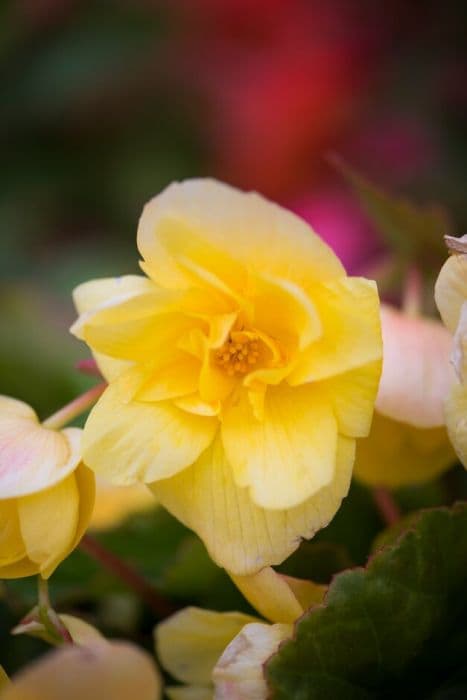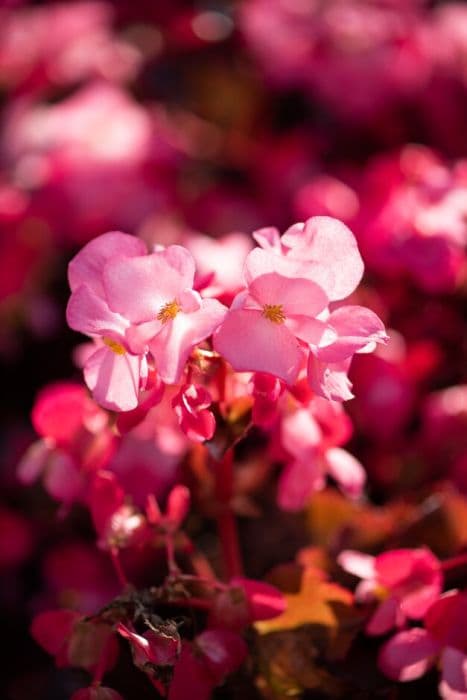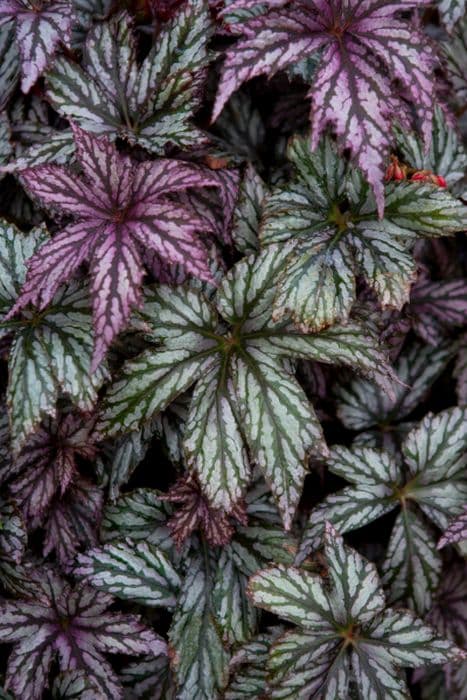Begonia Begonia Sherbet Bon Bon = 'Yabon'
![begonia [Sherbet Bon Bon]](/_next/image?url=https%3A%2F%2Fplants-admin.emdemapps.com%2Fimages%2Fplants%2F%2Fimages%2F604b5f2308ec2.png&w=3840&q=75)
ABOUT
The Begonia Sherbet Bon Bon, commonly referred to as Begonia 'Yabon', is captivating with its vibrant foliage and ornamental qualities. It features lush leaves that are unique in their asymmetrical, heart-shaped form, presenting a dynamic visual texture. The leaves exhibit a blend of colors, typically with a green base that can vary in intensity from light to darker shades. Superimposed on this verdant background are patterns that can best be described as reminiscent of sherbet, with pastel hues that may include pinks, oranges, and yellows, creating a delectable confection-like appearance. One of the most striking aspects of Begonia 'Yabon' is its surface texture. The leaf's surface often appears to be dusted with a sugary coating, providing a subtle sparkle that enhances its overall allure. Additionally, the foliage may display a mix of matte and gloss finishes, which catches the light differently and adds to the plant's dynamic presentation. The plant's undersides are not to be overlooked, as they often present with a reddish or maroon tone, which contrasts beautifully with the lighter tones of the upper leaf surfaces. Begonia 'Yabon' also produces delicate flowers that offer a further touch of charm, although it is the foliage that usually takes center stage. These blossoms tend to be small and may come in soft colors that complement the leaves. Overall, Begonia 'Yabon' brings a splash of color and textural interest to spaces without being overwhelming. It is often sought after for its decorative appearance, which can elevate the ambience of both indoor and outdoor settings. Its harmonious blend of colors and the sweet, dessert-like quality of its variegated leaves make it a delightful addition for plant enthusiasts looking to enrich their collection with a touch of visual sweetness.
About this plant
 Names
NamesFamily
Begoniaceae
Synonyms
Sherbet Bon Bon Begonia, Yabon Begonia
Common names
Begonia 'Yabon'.
 Toxicity
ToxicityTo humans
Begonias, including the Begonia Sherbet Bon Bon, contain insoluble oxalates which can cause irritation to the mouth, lips, tongue, and throat if ingested. Additionally, swallowing parts of the plant can result in nausea, vomiting, and diarrhea. It is advised to keep this plant out of reach of children who might inadvertently consume its parts.
To pets
Begonias are toxic to pets due to the presence of insoluble oxalates. If a pet ingests any part of a Begonia, they may experience symptoms such as drooling, vomiting, and difficulty swallowing due to irritation and burning of the mouth, lips, and tongue. In severe cases, ingestion can lead to difficulty breathing and more severe gastrointestinal upset. Pets should not be allowed to chew on or ingest this plant.
 Characteristics
CharacteristicsLife cycle
Perennials
Foliage type
Evergreen
Color of leaves
Mixed
Flower color
Mixed
Height
1-2 feet (30-60 cm)
Spread
1-2 feet (30-60 cm)
Plant type
Herb
Hardiness zones
10
Native area
Tropical regions
Benefits
 General Benefits
General Benefits- Ornamental Appeal: Adds vibrant color and unique texture to gardens or indoor spaces with its striking foliage and blooms.
- Low Maintenance: Requires minimal care, making it suitable for gardeners of all levels.
- Shade Tolerance: Thrives in shaded areas where other plants might struggle, offering design flexibility.
- Drought Resistance: Once established, has good tolerance to dry conditions, reducing the need for frequent watering.
- Pest Resistance: Has natural resistance to many common garden pests, minimizing the need for chemical treatments.
- Versatility: Suitable for planting in containers, hanging baskets, or directly in the soil, giving a range of horticultural uses.
- Seasonal Interest: Offers year-round interest with evergreen leaves in mild climates or as a houseplant.
- Propagates Easily: Can be easily propagated from leaf cuttings, making it simple to create more plants for personal use or sharing.
- Compact Growth: Ideal for small spaces due to its compact growth habit.
 Medical Properties
Medical PropertiesThis plant is not used for medical purposes.
 Air-purifying Qualities
Air-purifying QualitiesThis plant is not specifically known for air purifying qualities.
 Other Uses
Other Uses- Craft Projects: The vibrant foliage of begonias can be used in pressed flower crafts, such as making unique greeting cards or bookmarks.
- Photography Prop: The distinctive leaves and colors of begonias can serve as an excellent prop in still life photography.
- Educational Tool: Begonias can be used in schools or educational programs to teach about plant biology and hybridization processes.
- Culinary Ornamentation: Edible varieties of begonias can be used as pretty, non-toxic garnishes for plating and presenting dishes.
- Fairy Gardens: Begonias can be incorporated into fairy gardens for their bright colors and textures to create a magical miniature landscape.
- Art Inspiration: The unique appearance of begonias can act as inspiration for artists looking for organic shapes and colors in their artwork.
- Color Dye: Some types of begonias can be used to create natural dyes for fabrics or paper, although this is not a common use.
- Personalizing Pottery: Leaves of begonias can be pressed into wet clay to create interesting patterns on pots or tiles before firing.
- Perfumery: In some instances, fragrant varieties of begonias might be used as a source of scent for natural perfumes or potpourris.
- Seasonal Decorations: Use the colorful leaves and flowers in seasonal decorations, such as autumn displays or spring centerpieces.
Interesting Facts
 Feng Shui
Feng ShuiThe Begonia is not used in Feng Shui practice.
 Zodiac Sign Compitability
Zodiac Sign CompitabilityThe Begonia is not used in astrology practice.
 Plant Symbolism
Plant Symbolism- Caution: Begonias are often associated with a warning to be cautious or a signal that there might be a situation requiring vigilance or attention.
- Gratitude: The action of giving begonias can symbolize gratitude, making them a considerate gift when you want to thank someone.
- Uniqueness: With its distinctive color and pattern, the Begonia Sherbet Bon Bon reflects the concept of uniqueness or standing out from others.
- Individuality: Similarly to uniqueness, begonias may represent someone's individuality and distinctive personality.
- Harmony: Begonias can evoke a sense of harmony and balance, perhaps due to their symmetrical blooming pattern and how they bring beauty to their surroundings.
 Water
WaterThe Begonia 'Sherbet Bon Bon' should be watered regularly but with care to avoid overwatering. It's essential to allow the top inch of soil to dry out before watering again. When watering, use lukewarm water and thoroughly soak the soil until excess water drains from the bottom of the pot. A good rule of thumb is to provide approximately one to two cups (8-16 ounces) of water each time you water the plant, which might typically be once a week, but this can vary depending on the humidity and temperature of your environment.
 Light
LightBegonia 'Sherbet Bon Bon' prefers bright, indirect light. A north-facing window or an east-facing window where it can receive gentle morning sun and shade during the more intense afternoon light is ideal for this plant. Avoid direct sunlight, particularly in hot summer months, as it can scorch the leaves.
 Temperature
TemperatureThe Begonia 'Sherbet Bon Bon' thrives in temperatures between 65°F to 75°F, which are typical room temperatures. It's important to avoid temperatures below 50°F, as cold drafts can harm the plant. Always keep your Begonia 'Sherbet Bon Bon' away from cold windows, doorways, and air conditioning vents.
 Pruning
PruningPrune the Begonia 'Sherbet Bon Bon' to maintain its shape and encourage bushier growth. The best time for pruning is in the spring or after the blooming cycle has completed. Remove dead or yellowing leaves and trim back any leggy stems to enhance the plant's appearance and promote healthy growth. Pruning every few months will keep your plant looking vibrant and full.
 Cleaning
CleaningAs needed
 Soil
SoilThe Begonia 'Yabon' thrives in well-draining soil rich in organic matter, with an ideal mix being one part peat, one part pine bark, and one part perlite or coarse sand. The soil pH should be slightly acidic to neutral, ranging from 5.5 to 7.0 for optimal growth.
 Repotting
RepottingBegonias like 'Yabon' should be repotted every 1-2 years or when the plant becomes rootbound. It's best to repot during spring or early summer, which allows the plant to recover and grow actively during the growing season.
 Humidity & Misting
Humidity & MistingBegonia 'Yabon' prefers a humidity level between 50% to 70%. High humidity is crucial for healthy growth, but good air circulation is also important to prevent fungal diseases.
 Suitable locations
Suitable locationsIndoor
Ensure bright, indirect light and high humidity.
Outdoor
Protect from direct sun; keep in dappled shade.
Hardiness zone
10-11 USDA
 Life cycle
Life cycleThe Begonia 'Yabon', commonly known as Begonia Sherbet Bon Bon, begins its life as a seed, germinating in warm, moist soil with plenty of indirect light. Upon sprouting, the seedling grows into a young plant with small leaves that gradually increase in size, continuing to require consistent moisture and indirect sunlight. As it matures, the Begonia Sherbet Bon Bon develops its characteristic foliage, typically lush and vibrant, with the leaves often displaying unique patterns or colors that may change with the seasons. The plant will then flower, producing delicate blossoms that can add ornamental value, though Begonias are primarily grown for their foliage. After the flowering stage, if pollination occurs, the plant may produce seeds, which can be harvested and sown to propagate new plants. Eventually, as the plant ages and enters the senescence phase, growth slows down, and it may become more susceptible to disease or environmental stress, leading to its eventual decline.
 Propogation
PropogationPropogation time
Spring-Summer
Propogation: The Begonia 'Sherbet Bon Bon', often referred to by its cultivar name 'Yabon', can be propagated through the popular method of stem cuttings. The best time to propagate is during the growing season, typically spring or early summer, when the plant has the most vigor to heal and root. To propagate, one would take a stem cutting around 3-4 inches long, making sure it has at least one node, the part of the stem where leaves and buds emerge. Remove the leaves from the lower half of the cutting to prevent rot and dip the cut end in rooting hormone to encourage root growth. Plant the cutting in a mix of peat and perlite, ensuring high humidity and warm temperatures around 70°F (circa 21°C), while avoiding direct sunlight. Roots usually develop within a few weeks, after which the new plant can be transplanted to its permanent pot.





![Begonia [Devotion]](/_next/image?url=https%3A%2F%2Fplants-admin.emdemapps.com%2Fimages%2Fplants%2F%2Fimages%2F604b58183573b.png&w=640&q=75)



